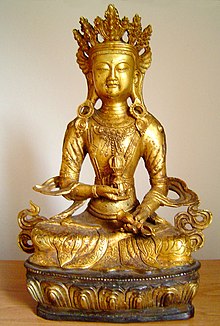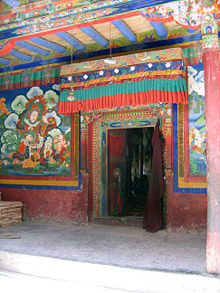From Wikipedia, the free encyclopedia
Tibetan Buddhism[1] is the body of Buddhist religious doctrine and institutions characteristic of
Tibet and certain regions of the
Himalayas, including northern
Nepal,
Bhutan, and
India (particularly in
Arunachal Pradesh,
Ladakh,
Dharamsala,
Lahaul and
Spiti in
Himachal Pradesh, and
Sikkim). It is the state religion of
Bhutan.
[2] It is also practiced in
Mongolia and parts of
Russia (
Kalmykia,
Buryatia, and
Tuva) and
Northeast China. Texts recognized as scripture and commentary are contained in the
Tibetan Buddhist canon, such that
Tibetan is a spiritual language of these areas.
In the wake of the
1959 Tibetan uprising, a
Tibetan diaspora has made Tibetan Buddhism more widely accessible to the rest of the world. It has since spread to many Western countries, where the tradition has gained popularity. Among its prominent exponents is the
14th Dalai Lama of Tibet. The number of its adherents is estimated to be between ten and twenty million.
[3]
[edit] Buddhahood
Tibetan Buddhism comprises the teachings of the three
vehicles of
Buddhism: the
Foundational Vehicle,
Mahāyāna, and
Vajrayāna. The Mahāyāna goal of spiritual development is to achieve the enlightenment of
Buddhahood in order to most efficiently help all other sentient beings attain this state.
[4] The motivation in it is the
bodhicitta mind of enlightenment — an altruistic intention to become enlightened for the sake of all sentient beings.
[5] Bodhisattvas are revered beings who have conceived the
will and vow to dedicate their lives with
bodhicitta for the sake of all beings. Tibetan Buddhism teaches methods for achieving Buddahood more quickly by including the Vajrayāna path in Mahāyāna.
[6]
Buddhahood is defined as a state free of the obstructions to liberation as well as those to omniscience.
[7] When, in Buddhahood, one is freed from all mental obscurations,
[8] one is said to attain a state of continuous bliss mixed with a simultaneous cognition of emptiness,
[9] the true nature of reality
[10]. In this state, all limitations on one's ability to help other living beings are removed.
[11]
It is said that there are countless beings who have attained Buddhahood.
[12] Buddhas spontaneously, naturally and continuously perform activities to benefit all sentient beings.
[13] However it is believed that sentient beings'
karmas limit the ability of the Buddhas to help them. Thus, although Buddhas possess no limitation from their side on their ability to help others, sentient beings continue to experience suffering as a result of the limitations of their own former negative actions.
[14]
[edit] Tibetan definitions of "Buddhist"
Introspection as the mark of a Buddhist is embodied in the Tibetan term for Buddhist:
[15] literally, "internalist".
[16]
More precisely, Tibetans specify two alternative criteria for being Buddhist - a) formal: having taken
refuge[17] and b) in belief: acceptance of the
four marks of existence.
[edit] General methods of practice
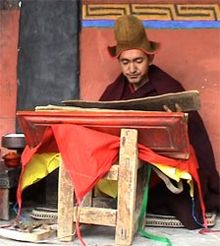
Buddhist monk Geshe Konchog Wangdu reads
Mahayana sutras from an old woodblock copy of the Tibetan Kanjur.
[edit] Transmission and realisation
An emphasis on oral transmission as more important than the printed word derives from the earliest period of Indian Buddhism, when it allowed teachings to be kept from those who should not hear them.
[18] Hearing a teaching (transmission) readies the hearer for realisation based on it. The person from whom one hears the teaching should have heard it as one link in a succession of listeners going back to the original speaker: the Buddha in the case of a sutra or the author in the case of a book. Then the hearing constitutes an authentic lineage of transmission. Authenticity of the oral lineage is a prerequisite for realisation, hence the importance of
lineages.
Merely reading about a teaching is helpful but no substitute for receiving a transmission on it. Listening to a text recited aloud by someone who holds the lineage for transmission of that text makes oneself also a holder of that lineage and the more ready for realization of the teaching in it. Oral transmissions by lineage holders traditionally can take place in small groups or mass gatherings of listeners and may last for seconds (in the case of a mantra, for example) or months (as in the case of a section of the
canon). A transmission can even occur without actually hearing, as in Asaṅga's visions of Maitreya.
[citation needed]
[edit] Analytic meditation and fixation meditation
Spontaneous realisation on the basis of transmission is possible but rare. Normally an intermediate step is needed in the form of analytic meditation, i.e., thinking about what one has heard. As part of this process, entertaining doubts and engaging in internal debate over them is encouraged in some traditions.
[19]
Analytic meditation is just one of two general methods of meditation. When it achieves the quality of realisation, one is encouraged to switch to "focused" or "fixation" meditation. In this the mind is stabilised on that realisation for periods long enough to gradually habituate it to it.
A person's capacity for analytic meditation can be trained with logic. The capacity for successful focused meditation can be trained through
calm abiding. A meditation routine may involve alternating sessions of analytic meditation to achieve deeper levels of realization, and focused meditation to consolidate them.
[10] The deepest level of realization is Buddhahood itself.
[edit] Skepticism and devotion to the guru
Two characteristic aspects of Tibetan Buddhism are skepticism and devotion to the guru
[20] which have led it into conflict with Chinese socialism and so invited the destruction of the Tibetan intelligentsia under
Mao.
[21] An attitude of critical skepticism is encouraged to promote abilities in analytic meditation. However, as in other Buddhist traditions, an attitude of reverence for the teacher is also highly prized.
In favour of skepticism towards Buddhist doctrines in general, Tibetans are fond of quoting sutra to the effect that one should test the Buddha's words as one would the quality of gold.
[22] On the other hand, at the beginning of a public teaching, a lama will do prostrations to the throne on which he will teach due to its symbolism, or to an image of the Buddha behind that throne, then students will do prostrations to the lama after he is seated. Merit accrues when one's interactions with the teacher are imbued with such reverence in the form of guru devotion, a code of practices governing them that derives from Indian sources.
[23] By such things as avoiding disturbance to the peace of mind of one's teacher, and wholeheartedly following his prescriptions, much merit accrues and this can significantly help improve one's practice.
There is a general sense in which any Tibetan Buddhist teacher is called a lama. A student may have taken teachings from many authorities and revere them all as lamas in this general sense. However, he will typically have one held in special esteem as his own root guru and is encouraged to view the other teachers who are less dear to him, however more exalted their status, as embodied in and subsumed by the root guru.
[24] Often the teacher the student sees as root guru is simply the one who first introduced him to Buddhism, but a student may also change his personal view of which particular teacher is his root guru any number of times.
The opposing principles of skepticism and guru devotion are reconciled with the Tibetan injunction to scrutinise a prospective guru thoroughly before finally adopting him as such without reservation. A Buddhist may study with a lama for decades before finally accepting him as his own guru.
[edit] Preliminary practices and the Tibetan approach to Vajrayāna
Vajrayāna is said to be the fastest method for attaining Buddhahood but for unqualified practitioners it can be dangerous. To engage in it one must receive an appropriate initiation (also known as an "empowerment") from a lama who is fully qualified to give it. From the time one has resolved to accept such an initiation, the utmost sustained effort in guru devotion is essential.
The aim of
preliminary practices (
ngöndro) is to start the student on the correct path for such higher teachings.
[25] Just as Sutrayāna preceded Vajrayāna historically in India, so sutra practices constitute those that are preliminary to tantric ones. Preliminary practices include all
Sutrayāna activities that yield merit like hearing teachings, prostrations, offerings, prayers and acts of kindness and compassion, but chief among the preliminary practices are realizations through meditation on the three principle stages of the path: renunciation, the altruistic
bodhicitta wish to attain enlightenment and the wisdom realizing emptiness. For a person without the basis of these three in particular to practice Vajrayāna can be like a small child trying to ride an unbroken horse.
[26]
While the practices of Vajrayāna are not known in Sutrayāna, all Sutrayāna practices are common to Vajrayāna. Without training in the preliminary practices, the ubiquity of allusions to them in Vajrayāna is meaningless and even successful Vajrayāna initiation becomes impossible.
The merit acquired in the preliminary practices facilitates progress in Vajrayāna. While many Buddhists may spend a lifetime exclusively on sutra practices, however, an amalgam of the two to some degree is common. For, example, in order to train in
calm abiding, one might use a tantric visualisation as the meditation object.
[edit] Esotericism
In Vajrayāna particularly, Tibetan Buddhists subscribe to a voluntary code of self-censorship, whereby the uninitiated do not seek and are not provided with information about it. This self-censorship may be applied more or less strictly depending on circumstances such as the material involved. A depiction of a mandala may be less public than that of a deity. That of a higher tantric deity may be less public than that of a lower. The degree to which information on Vajrayāna is now public in western languages is controversial among Tibetan Buddhists.
Buddhism has always had a taste for
esotericism since its earliest period in India.
[27] Tibetans today maintain greater or lesser degrees of confidentiality also with information on the
vinaya and
emptiness specifically. In Buddhist teachings generally, too, there is caution about revealing information to people who may be unready for it. Esoteric values in Buddhism have made it at odds with the values of Christian missionary activity, for example in contemporary Mongolia.
[edit] Native Tibetan developments
Some commentators have emphasised Tibetan innovations such as the system of
incarnate lamas,
[28] but such genuine innovations have been few.
[29] True to its roots in the
Pāla system of North India, however, Tibetan Buddhism carried on a tradition of eclectic accumulation and systematisation of diverse Buddhist elements, and pursued their synthesis. Prominent among these achievements are the
Stages of the Path and
motivational training.
[edit] Study of tenet systems in Tibetan Buddhism

Monks debating in
Drepung Monastery
Tibetan Buddhists practice one or more understandings of the true nature of reality, the
emptiness of inherent existence of all things. Emptiness is propounded according to four classical Indian schools of philosophical tenets.
Two belong to the older path of the
Foundation Vehicle:
The primary source for the former is the
Abhidharma-kośa by
Vasubandhu and its commentaries. The Abhidharmakośa is also an important source for the Sautrāntikas.
Dignāga and
Dharmakīrti are the most prominent exponents.
The other two are
Mahayana (Skt.
Greater Vehicle) (Tib.
theg-chen):
Yogacārins base their views on texts from
Maitreya,
Asaṅga and
Vasubandhu, Madhyamakas on
Nāgārjuna and
Āryadeva. There is a further classification of Madhyamaka into
Svatantrika-Madhyamaka and
Prasaṅgika-Madhyamaka. The former stems from
Bhavaviveka,
Śāntarakṣita and
Kamalaśīla, and the latter from
Buddhapālita and
Candrakīrti.
The tenet system is used in the monasteries and colleges to teach Buddhist philosophy in a systematic and progressive fashion, each philosophical view being more subtle than its predecessor. Therefore the four schools can be seen as a gradual path from a rather easy-to-grasp, "realistic" philosophical point of view, to more and more complex and subtle views on the ultimate nature of reality, that is on emptiness and
dependent arising, culminating in the philosophy of the Mādhyamikas, which is widely believed to present the most sophisticated point of view.
[30]
[edit] History
[edit] Early history
According to a Tibetan legendary tradition, Buddhist scriptures including the
Kāraṇḍavyūhasūtra and relics including the
cintamaṇi arrived in southern Tibet in the fifth century during the reign of Lha
Thothori Nyantsen, the 28th king of Tibet. The tale is miraculous: the objects fell from the sky on the roof of the king's palace, but it may have a historical background in the form of the arrival of Buddhist missionaries.
[31]
The earliest well-documented influence of Buddhism in Tibet dates from the reign of king
Songtsän Gampo, who died in 650. He married a Chinese
Tang Dynasty Buddhist princess,
Wencheng, who came to Tibet with a statue of Shakyamuni Buddha.
[32]

Padmasambhāva, founder of the
Nyingmapa, the earliest school of Tibetan Buddhism. Note the wide-open eyes, characteristic of a particular method of meditation.
[33] According to a Tibetan legendary tradition, Songtsän Gampo also married a Nepalese Buddhist princess,
Bhrikuti; but Bhrikuti, who bears the name of a goddess, is not mentioned in reliable sources.
[citation needed] Songtsän Gampo founded the first Buddhist temples. By the second half of the 8th century he was already regarded as an embodiment of the bodhisattva
Avalokiteśvara.
[34]
The successors of Songtsän Gampo were less enthusiastic about the propagation of Buddhism but in the 8th century, King
Trisong Detsen (755-797) established it as the official religion of the state.
[35] He invited Indian Buddhist scholars to his court. In his age the famous tantric mystic
Padmasambhāva arrived in Tibet according to the Tibetan tradition. In addition to writing a number of important scriptures, some of which he hid for future
tertons to find, Padmasambhāva, along with Śāntarakṣita, established the
Nyingma school.
The outlines of the history of Buddhism in Tibet from this time are well-known.
[36] At this early time also, from the south came the influence of scholars under the
Pāla dynasty in the Indian state of Magadha. They had achieved a blend of
Mahayana and
Vajrayana that has come to characterize all forms of Tibetan Buddhism. Their teaching in sutra centred on the
Abhisamayālankāra, a fourth century
Yogacārin text, but prominent among them were the
Mādhyamika scholars
Śāntarakṣita and
Kamalaśīla.
A third influence was that of the
Sarvāstivādins from Kashmir in the south west
[37] and
Khotan in the north west.
[38] Although they did not succeed in maintaining a presence in Tibet, their texts found their way into the
Tibetan Buddhist canon, providing the Tibetans with almost all of their primary sources about the
Foundation Vehicle. A subsect of this school,
Mūlasarvāstivāda was the source of the Tibetan
vinaya.
[39]
A fourth influence from China in the east came in the form of Chan.
[edit] Transmission of Chan to the Nyingmapa
According to A. W. Barber of the University of Calgary
[40],
Chan Buddhism was introduced to the
Nyingmapa in three principal streams: the teachings of Master Kim,
Kim Ho-shang, (Chin ho shang) 金和尚 transmitted by
Sang Shi[41] in
ca. 750 CE; the lineage of Master
Wu Chu (無住禪師) of the Pao T'ang School was transmitted within Tibet by Ye-shes Wangpo; and the teaching from
Mo Ho Yen, 和尚摩訶衍 (Tibetan:
Hwa shang Mahayana) that were a synthesis of the Northern School of Chan and the Pao T'ang School.
[42]
Tibetan king
Khri srong lde btsan (742–797) invited the Ch’an master Mo-ho-yen (whose name consists of the same Chinese characters used to transliterate “
Mahayana”) to transmit the Dharma at Samye Monastery. Mo-ho-yen had been disseminating Dharma in the Tun-huang locale, but, according to Tibetan sources, lost an important philosophical debate on the nature of emptiness with the Indian master Kamalaśīla, and the king declared Kamalaśīla's philosophy should form the basis for Tibetan Buddhism.
[43] However, a Chinese source says their side won, and some scholars conclude that the entire episode is fictitious.
[44] Pioneering Buddhologist
Giuseppe Tucci speculated that Hwashang's ideas were preserved by the Nyingmapas in the form of
dzogchen teachings.
[45]
Whichever may be the case, Tibetan Buddhists today trace their spiritual roots from Indian masters such as
Padmasambhāva,
Atiśa,
Tilopa,
Naropa and their later Tibetan students.
[edit] Later history
From the outset Buddhism was opposed by the native shamanistic
Bön religion, which had the support of the aristocracy, but with royal patronage it thrived to a peak under King Rälpachän (817-836). Terminology in translation was standardised around 825, enabling a translation methodology that was highly literal. Despite a reversal in Buddhist influence which began under King Langdarma (836-842), the following centuries saw a colossal effort in collecting available Indian sources, many of which are now extant only in Tibetan translation.
Tibetan Buddhism exerted a strong influence from the 11th century CE among the peoples of
Central Asia, especially in
Mongolia and
Manchuria. It was adopted as an official state religion by the
Mongol Yuan dynasty and the
Manchu Qing dynasty that ruled
China. Coinciding with the early discoveries of "
hidden treasures" (
terma),
[46] the 11th century saw a revival of Buddhist influence originating in the far east and far west of Tibet.
[47] In the west,
Rinchen Zangpo (958-1055) was active as a translator and founded temples and monasteries. Prominent scholars and teachers were again invited from India. In 1042
Atiśa arrived in Tibet at the invitation of a west Tibetan king. This renowned exponent of the Pāla form of Buddhism from the Indian university of Vikramaśīla later moved to central Tibet. There his chief disciple, Dromtonpa founded the
Kadampa school of Tibetan Buddhism, under whose influence the
New Translation schools of today evolved.
[edit] Schools
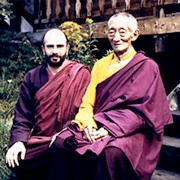
Kalu Rinpoche (right) and Lama Denys at Karma Ling Institute in Savoy
Tibetan Buddhism has four main traditions:
- Kagyu(pa), “Lineage of the (Buddha's) Word”. This is an oral tradition which is very much concerned with the experiential dimension of meditation. Its most famous exponent was Milarepa, an eleventh century mystic. It contains one major and one minor subsect. The first, the Dagpo Kagyu, encompasses those Kagyu schools that trace back to the Indian master Naropa via Marpa, Milarepa and Gampopa[49] and consists of four major sub-sects: the Karma Kagyu, headed by a Karmapa, the Tsalpa Kagyu, the Barom Kagyu, and Pagtru Kagyu. There are further eight minor sub-sects, all of which trace their root to Pagtru Kagyu and the most notable of which are the Drikung Kagyu and the Drukpa Kagyu. The once-obscure Shangpa Kagyu, which was famously represented by the 20th century teacher Kalu Rinpoche, traces its history back to the Indian master Naropa via Niguma, Sukhasiddhi and Kyungpo Neljor.[49]
- Sakya(pa), “Grey Earth”. This school very much represents the scholarly tradition. Headed by the Sakya Trizin, this tradition was founded by Khon Konchog Gyalpo, a disciple of the great translator Drokmi Lotsawa and traces it's lineage to the Indian master Virupa.[49] A renowned exponent, Sakya Pandita 1182–1251CE was the great grandson of Khon Konchog Gyalpo.
- Gelug(pa), “Way of Virtue”. Originally a reformist movement, this tradition is particularly known for its emphasis on logic and debate. Its spiritual head is the Ganden Tripa and its temporal one the Dalai Lama. The Dalai Lama is regarded as the embodiment of the Bodhisattva of Compassion[51] Successive Dalai Lamas ruled Tibet from the mid-17th to mid-20th centuries. The order was founded in the 14th to 15th century by Je Tsongkhapa, renowned for both his scholasticism and his virtue.
These major schools are sometimes said to constitute the
”Old Translation” and
”New Translation” traditions, the latter following from the historical
Kadampa lineage of translations and tantric lineages.
Another common differentiation is into "
Red Hat" and "
Yellow Hat" schools. The correspondences are as follows:
| Nyingma | Kagyu | Sakya | Gelug |
| Old Translation | New Translation | New Translation | New Translation |
| Red Hat | Red Hat | Red Hat | Yellow Hat |
Besides these major schools, there is a minor one, the
Jonang. The Jonangpa were suppressed by the rival Gelugpa in the 1600s and were once thought extinct, but are now known to survive in
Eastern Tibet.
There is also an
ecumenical movement known as
Rimé.
[52]
[edit] Monasticism
Although there were many
householder-
yogis in Tibet, monasticism was the foundation of Buddhism in Tibet. There were over 6,000 monasteries in Tibet, but nearly all were ransacked and destroyed by
Red Guards during the
Cultural Revolution.
[53] Most of the major ones have been at least partially re-established but many still remain in ruins.
In
Mongolia during the 1920s, approximately one third of the male population were monks, though many lived outside monasteries. By the beginning of the 20th century about 750 monasteries were functioning in Mongolia.
[54] These monasteries were largely dismantled during Communist rule, but many have been reestablished during the Buddhist revival in Mongolia
[citation needed] which followed the fall of Communism.
Monasteries generally adhere to one particular school. Some of the major centers in each tradition are as follows:
[edit] Nyingma
The
Nyingma lineage is said to have "six mother monasteries," although the composition of the six has changed over time:
Also of note is
Many
Kagyu monasteries are in Kham, eastern Tibet. Tsurphu, one of the most important, is in central Tibet, as is Ralung and Drikung.
The three most important centers of the
Gelugpa lineage are
Ganden,
Sera and
Drepung Monasteries, near Lhasa:
Three other monasteries have particularly important regional influence:
Great spiritual and historical importance is also placed on:
[edit] Tibetan Buddhism in the contemporary world
Today, Tibetan Buddhism is adhered to widely in the
Tibetan Plateau,
Nepal,
Bhutan,
Mongolia,
Kalmykia (on the north-west shore of the Caspian),
Siberia (central Russia, specifically
Buryatia and
Chita Oblast), and the
Russian Far East (concentrated in
Tuva). The
Indian regions of
Sikkim and
Ladakh, both formerly independent kingdoms, are also home to significant Tibetan Buddhist populations. In the wake of the
Tibetan diaspora, Tibetan Buddhism has gained adherents in the West and throughout the world. Celebrity practitioners include
Brandon Boyd,
Richard Gere,
Adam Yauch,
Jet Li,
Sharon Stone,
Allen Ginsberg,
Philip Glass and
Steven Seagal (who has been proclaimed the reincarnation of the
tulku Chungdrag Dorje).
[55]
[edit] Glossary of Terms Used
| English | spoken Tibetan | Wylie Tibetan | Sanskrit transliteration |
| affliction | nyönmong | nyon-mongs | kleśa |
| analytic meditation | jegom | dpyad-sgom | – |
| calm abiding | shiné | zhi-gnas | śamatha |
| devotion to the guru | lama-la tenpa | bla-ma-la bsten-pa | guruparyupāsati |
| fixation meditation | joggom | 'jog-sgom | – |
| foundational vehicle | t’ek män | theg sman | hīnayāna |
| incarnate lama | tülku | sprul-sku | nirmānakāya |
| inherent existence | rangzhingi drubpa | rang-bzhin-gyi grub-pa | svabhāvasiddha |
| preliminary practices | ngöndo | sngon-'gro | – |
| root guru | zawé lama | rtsa-ba'i bla-ma | – |
| stages of the path | lamrim | lam-rim | – |
| motivational training | lojong | blo-sbyong | – |
| mind of enlightenment | changchub sem | byang-chhub sems | bodhicitta |
| omniscience | t’amcé k’yempa | thams-cad mkhyen-pa | sarvajñā |
| transmission and realisation | lungtok | lung-rtogs | āgamādhigama |
[edit] See also
- ^ An alternative term, "lamaism", apparently derives from Chinese lama jiao and was used to distinguish Tibetan Buddhism from Han Chinese Buddhism, fo jiao. The term was taken up by western scholars including Hegel, as early as 1822 (Lopez, Donald S. Jr. (1999). Prisoners of Shangri-La: Tibetan Buddhism and the West. Chicago: University of Chicago Press. pp. 6, 19f. ISBN 0226493113. ). Insofar as it implies a discontinuity between Indian and Tibetan Buddhism, the term has been discredited (Conze, 1993).
- ^ The 2007 U.S. State Department report on religious freedom in Bhutan notes that "Mahayana Buddhism is the state religion..." and that the Bhutanese government supports both the Kagyu and Nyingma sects. http://www.state.gov/g/drl/rls/irf/2007/90227.htm
- ^ Adherents.com estimates twenty million for Lamaism (Vajrayana/Tibetan/Tantric).
- ^ Cf. Dhargyey (1978), 111; Pabongka Rinpoche, 533f; Tsong-kha-pa II: 48-9
- ^ Thurman, Robert (1997). Essential Tibetan Buddhism. Castle Books: 291
- ^ Thurman, Robert (1997): 2-3
- ^ Cf. Dhargyey (1978), 64f; Dhargyey (1982), 257f, etc; Pabongka Rinpoche, 364f; Tsong-kha-pa II: 183f. The former are the afflictions, negative states of mind, and the three poisons – desire, anger, and ignorance. The latter are subtle imprints, traces or "stains" of delusion that involves the imagination of inherent existence.
- ^ Pabongka Rinpoche, 152f
- ^ Pabongka Rinpoche, 243, 258
- ^ a b Hopkins (1996)
- ^ Dhargyey (1978), 61f; Dhargyey (1982), 242-266; Pabongka Rinpoche, 365
- ^ Pabongka Rinpoche, 252f
- ^ Pabongka Rinpoche, 367
- ^ Dhargyey (1978), 74; Dhargyey (1982), 3, 303f; Pabongka Rinpoche, 13f, 280f; Berzin, Alexander (2002). Introductory Comparison of Hinayana and Mahayana
- ^ nangpa, nang-pa: Pabongka Rinpoche, 785
- ^ In this connection a story is told about Āryadeva. In preparation for debate with a non-Buddhist, he made a public display of cleaning the outside of a cess-pot. When asked why he was ignoring the inside, he explained that was what non-Buddhists did by obsession with external things like ritual. Cf. Geshe Ngawang Dhargyey, c.1976, Discourse on Āryadeva's Four Hundred Verses. LTWA, Dharmsala. On an analogous need for “non-interference” in Theravada Buddhism, cf. Nyanaponika Thera (1965), 81.
- ^ Tsong-kha-pa I, 189, 203f
- ^ Conze (1993): 26
- ^ Cf.Pabongka Rinpoche, 66, 212f
- ^ Lama is the literal Tibetan translation of the Sanskrit guru. For a traditional perspective on devotion to the guru, see Tsong-ka-pa I, 77-87. For a current perspective on the guru-disciple relationship in Tibetan Buddhism, see Berzin, Alexander. Relating to a Spiritual Teacher: Building a Healthy Relationship
- ^ Avedon, John F. (1988). Tibet Today. Current Conditions and Prospects. London: Wisdom. pp. 20. ISBN 0861710843.
- ^ "Do not accept my Dharma merely out of respect for me, but analyze and check it the way a goldsmith analyzes gold, by rubbing, cutting and melting it." (Ghanavyuhasutra; sTug-po bkod-pa'i mdo; A Sutra [on Pure Realms] Spread Out in a Dense Array, as quoted in translation in The Berzin Archives: http://www.berzinarchives.com/web/en/archives/e-books/published_books/spiritual_teacher/pt3/spiritual_teacher_13.html. On the same need for skepticism in the satipatthāna tradition of Theravada Buddhism, cf. Nyanaponika Thera (1965), 83.
- ^ notably, Gurupancasika, Tib.: Lama Ngachupa, Wylie: bla-ma lnga-bcu-pa, “Fifty Verses of Guru-Devotion” by Aśvaghoṣa
- ^ Indian tradition (Cf. Saddharmapundarika Sutra II, 124) encourages the student to view the guru as representative of the Buddha himself.
- ^ Kalu Rinpoche (1986), The Gem Ornament of Manifold Instructions. Snow Lion, p. 21.
- ^ Pabongka Rinpoche, 649
- ^ Cf. Conze (1993), 26 and 52f.
- ^ Tib.: tulku, Wylie: sprul-ku
- ^ Conze (1993). Moreover, that even this is a distinctly Tibetan development is disputable. Two centuries before Buddhism was introduced to Tibet, in the fifth century CE, the Abhidharma teacher Buddhaghoṣa was declared by Sri Lankan elders to be a reincarnation of the bodhisattva Maitreya. Berzin, Alexander (2002). Introductory Comparison of Hinayana and Mahayana
- ^ Sopa & Hopkins (1977), 67-69; Hopkins (1996). Non-Tibetan scholars have suggested that historically, Madhyamaka predates Cittamātra, however. Cf. Conze (1993).
- ^ Studholme, Alexander: The Origins of Om Manipadme Hum, Albany, NY 2002, p. 14.
- ^ Powers 2004, pg. 39
- ^ Wallace, 1999: 183
- ^ Macdonald, Alexander: Religion in Tibet at the time of Srong-btsan sgam-po: myth as history, in: The History of Tibet, ed. Alex McKay, Vol. 1, London 2003, p. 354-363 (for the queens see p. 355); Dargyay, Eva: Srong-btsan sgam-po of Tibet: Bodhisattva and king, in: The History of Tibet, ed. Alex McKay, Vol. 1, London 2003, p. 364-378 (for the queens see p. 373).
- ^ Beckwith, C.I.: The revolt of 755 in Tibet, in: The History of Tibet, ed. Alex McKay, Vol. 1, London 2003, p. 273-285 (discusses the political background and the motives of the ruler).
- ^ Conze, 1993. For more detail, see Berzin, Alexander (1996). The History of the Early Period of Buddhism and Bon in Tibet
- ^ Conze, 1993, 106
- ^ Berzin, Alexander (2000). Introductory History of the Five Tibetan Traditions of Buddhism and Bon; Berzin, Alexander (1996). The Spread of Buddhism in Asia
- ^ Berzin, Alexander, as above
- ^ A.W. Barber
- ^ Sang Shi later became an abbot of Samye Monastery.
- ^ Barber, A. W. (1990). "The Unifying of Rdzogs Pa Chen Po and Ch'an". Chung-Hwa Buddhist Journal 3, 04.1990: 301–317.. http://www.chibs.edu.tw/publication/chbj/03/chbj0313.htm. Retrieved October 20, 2007.
- ^ Yamaguchi, Zuihō (undated). The Core Elements of Indian Buddhism Introduced into Tibet: A Contrast with Japanese Buddhism. Source: Thezensite.com (accessed: October 20, 2007)
- ^ Macmillan Encyclopedia of Buddhism (Volume One), page 70
- ^ Masao Ichishima, "Sources of Tibetan Buddhist Meditation." Buddhist-Christian Studies, Vol. 2, (1982), pp. 121-122, published by University of Hawai'i Press.
- ^ Berzin, Alexander. The Four Traditions of Tibetan Buddhism: Personal Experience, History, and Comparisons
- ^ Conze, 1993, 104ff
- ^ The Tibetan adjectival suffix -pa is translatable as "-ist" in English.
- ^ a b c d Berzin. Alexander (2000). Introductory History of the Five Tibetan Traditions of Buddhism and Bon: http://www.berzinarchives.com/web/en/archives/study/history_buddhism/general_histories/introduction_history_5_traditions_buddhism_bon.html
- ^ http://www.kagyuoffice.org/buddhism.nyingma.html. See section: The Nine Yana Journey
- ^ Sanskrit: Avalokiteśvara, Tibetan: Chenrezig.
- ^ Wylie: ris-med
- ^ "Tibetan monks: A controlled life". BBC News. March 20, 2008. http://news.bbc.co.uk/2/hi/asia-pacific/7307495.stm.
- ^ "Mongolia: The Bhudda and the Khan". Orient Magazine. http://www.orientmag.com/8-30.htm.
- ^ Statement by H.H. Penor Rinpoche Regarding the Recognition of Steven Seagal as a Reincarnation of the Treasure Revealer Chungdrag Dorje of Palyul Monastery
[edit] References
- Coleman, Graham, ed. (1993). A Handbook of Tibetan Culture. Boston: Shambhala Publications, Inc.. ISBN 1-57062-002-4.
- Conze, Edward (1993). A Short History of Buddhism (2nd ed.). Oneworld. ISBN 1851680667.
- Dhargyey, Geshe Ngawang; ed. Alexander Berzin, based on oral trans. by Sharpa Tulku (3rd edn, 1978). Tibetan Tradition of Mental Development. Dharmsala: Library of Tibetan Works and Archives. [A pithy lam-rim by a geshe appointed in 1973 by His Holiness the Dalai Lama as head of the translation team at the Tibetan Library.]
- Dhargyey, Geshe Ngawang; ed. Alexander Berzin, based on oral trans. by Sharpa Tulku (1982). An Anthology of Well-Spoken Advice on the Graded Paths of the Mind, Vol. I. Dharmsala: Library of Tibetan Works and Archives. ISBN 8186470298. [The first part of a more extensive lam-rim by a geshe appointed in 1973 by His Holiness the Dalai Lama as head of the translation team at the Tibetan Library. The language of this publication is very different from that of the 1978 work by the same lama due to widespread changes in choice of English terminology by the translators.]
- Hopkins, Jeffrey (1996). Meditation on Emptiness. Boston: Wisdom. ISBN 0861711106. [Definitive treatment of emptiness according to the Prasaṅgika-Madhyamaka school.]
- Lati Rinpoche; trans. & ed.: Elizabeth Napper (1980). Mind in Tibetan Buddhism: Oral Commentary on Ge-shay Jam-bel-sam-pel’s “Presentation of Awareness and Knowledge Composite of All the Important Points Opener of the Eye of New Intelligence. Valois, NY: Snow Lion. ISBN 0937938025.
- Mullin, Glenn H. (1998). Living in the Face of Death: The Tibetan Tradition. 2008 reprint: Snow Lion Publications, Ithica, New York. ISBN 978-1-55939-310-2.
- Nyanaponika Thera (1965). The Heart of Buddhist Meditation. Boston: Weiser. ISBN 0877280738.
- Pabongka Rinpoche; Ed. Trijang Rinpoche, transl. Michael Richards (3rd edn. 2006). Liberation in the Palm of Your Hand, A Concise Discourse on the Path to Enlightenment. Somerville, MA: Wisdom. ISBN 0861715004. [This famous lam-rim text was written from notes on an extended discourse by the Gelugpa geshe, Pabongka Rinpoche in 1921 and translated through extensive consultation with Achok Rinpoche (Library of Tibetan Works and Archives).]
- Powers, John. History as Propaganda: Tibetan Exiles versus the People's Republic of China (2004) Oxford University Press. ISBN 978-0-19-517426-7
- Ringu Tulku. The Ri-Me Philosophy of Jamgon Kongtrul the Great: A Study of the Buddhist Lineages of Tibet. Shambhala. ISBN 1-59030-286-9.
- Smith, E. Gene (2001). Among Tibetan Texts: History and Literature of the Himalayan Plateau. Boston: Wisdom Publications. ISBN 0-86171-179-3
- Sopa, Geshe Lhundup; Jeffrey Hopkins (1977). Practice and Theory of Tibetan Buddhism. New Delhi: B.I. Publications. ISBN 0091256216. [Part Two of this book, ‘’Theory: Systems of Tenets’’ is an annotated translation of ‘’Precious Garland of Tenets (Grub-mtha’ rin-chhen phreng-ba)’’ by Kön-chok-jik-may-wang-po (1728-1791).]
- The Great Treatise on the Stages of the Path to Enlightenment
- Tsong-kha-pa; the Lamrim Chenmo Translation Committee; Joshua Cutler, ed. in chief; Guy Newland, ed. (2000). The Great Treatise on the Stages of the Path to Enlightenment, Volume I. Canada: Snow Lion. ISBN 1559391529.
- Tsong-kha-pa; the Lamrim Chenmo Translation Committee; Joshua Cutler, ed. in chief; Guy Newland, ed. (2002). The Great Treatise on the Stages of the Path to Enlightenment, Volume II. Canada: Snow Lion. ISBN 1559391685.
- Tsong-kha-pa; the Lamrim Chenmo Translation Committee; Joshua Cutler, ed. in chief; Guy Newland, ed. (2004). The Great Treatise on the Stages of the Path to Enlightenment, Volume III. Canada: Snow Lion. ISBN 1559391669.
- Wallace, B. Alan (1999), "The Buddhist Tradition of Samatha: Methods for Refining and Examining Consciousness", Journal of Consciousness Studies 6 (2-3): 175-187 .
[edit] Further reading
- Introductory books
- Other books
- Coleman, Graham, ed. (1993). A Handbook of Tibetan Culture. Boston: Shambhala Publications, Inc.. ISBN 1-57062-002-4.
- Lati Rinpoche; trans. & ed.: Elizabeth Napper (1980). Mind in Tibetan Buddhism: Oral Commentary on Ge-shay Jam-bel-sam-pel’s “Presentation of Awareness and Knowledge Composite of All the Important Points Opener of the Eye of New Intelligence. Valois, NY: Snow Lion. ISBN 0937938025.
- Ringu Tulku. The Ri-Me Philosophy of Jamgon Kongtrul the Great: A Study of the Buddhist Lineages of Tibet. Shambhala. ISBN 1-59030-286-9.
- Smith, E. Gene (2001). Among Tibetan Texts: History and Literature of the Himalayan Plateau. Boston: Wisdom Publications. ISBN 0-86171-179-3
[edit] External links
[show] Buddhism topics
Dear Readers, please do not assume that you understand anything you read on this blog.(;-)


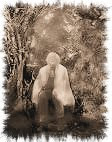.jpg)

.jpg)
.jpg)




